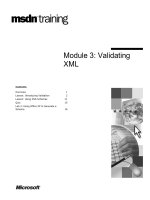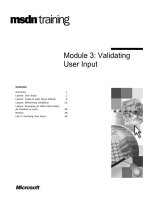Tài liệu Module 3: Using a Conceptual Design for Data Requirements docx
Bạn đang xem bản rút gọn của tài liệu. Xem và tải ngay bản đầy đủ của tài liệu tại đây (346.91 KB, 20 trang )
Module 3: Using a Conceptual Design
for Data Requirements
Module 1: Course
Overview
Module 4: Deriving a
Logical Data Design
Module 5: Normalizing the
Logical Data Design
Module 6: Deriving a
Physical Data Design
Module 7:
Implementing Data
Integrity
Module 2: Solution
Design Processes
Module 3: Using a
Conceptual Design for Data
Requirements
Module 8: Designing
Data Services
Module 9: Data Storage
Considerations
Designing Data
Services and
Data Models
Investigation
Process
Data
Requirements
Activity 3.1: Identifying
Data-Related Use Cases
and Data Requirements
Module 3: Using a
Conceptual Design for Data
Requirements
Activity 3.2: Relating Data
Requirements to
Conceptual Design
Module 3: Using a Conceptual Design for Data Requirements 47
!
!!
! Overview
"
Investigation Process
"
Data Requirements
"
Activity 3.2: Relating Data Requirements to Conceptual
Design
"
Review
In this module...
In this module...
At the end of this module, you will be able to:
"
Describe the information investigation process.
"
Determine functional data requirements from use cases.
"
Identify nonfunctional requirements that will affect a solution’s design.
Slide Objective
To provide an overview of
this module’s topics and
objectives.
48 Module 3: Using a Conceptual Design for Data Requirements
!
!!
! Investigation Process
"
Gathering Information
"
Analyzing Information
"
Creating Use Cases
In this section...
In this section...
In this section, the discussion will focus on the reasons for gathering and
analyzing data, as well as the formulation of this data into use cases. Use cases
will be the foundation for determining data requirements for the system.
Slide Objective
To introduce use cases and
nonfunctional requirements
that are used in the
solution’s conceptual
design.
Delivery Tip
This section provides an
overview of what students
would normally do to get
information about data and
nonfunctional requirements.
They will not actually do this
in the course. If students
want more information about
this process, refer them to
Course 1585: Gathering and
Analyzing Business
Requirements.
Module 3: Using a Conceptual Design for Data Requirements 49
Gathering Information
"
Identify necessary information
"
Identify sources for required information
"
Use perspectives when looking at source information
"
Gather information
$
Conduct interviews
$
Shadow
$
Collect artifacts
To identify data requirements, the project team starts a process of investigation.
This process involves gathering and analyzing data from users, systems, and
documentation to determine the current state and desired future state of the
solution.
Gathering data involves:
"
Determining what information is needed to identify the data, functional
requirements, and nonfunctional requirements.
"
Identifying sources from which to obtain relevant and supporting
information. Sources can include people, systems, and systems-support
documents.
"
Looking at source information from different perspectives to ensure that all
the relevant information is gathered from a particular source.
"
Gathering the information needed to determine requirements from the
identified sources. Information can be gathered in several ways:
• Conduct interviews with users, managers, and other customers.
• Shadow users, managers, and other customers to gain first-hand
knowledge of the skills and experience necessary to perform a task.
• Collect artifacts, such as printed documentation and manuals.
Slide Objective
To provide an
understanding of the
gathering phase as a part of
the investigation process.
Lead-in
You will take a look at the
gathering of information as it
relates to the investigation
process.
50 Module 3: Using a Conceptual Design for Data Requirements
Analyzing Information
"
Organization
$
Provide structure to the original information and remove
redundancies
"
Identification of relationships
$
Determine which groups of information are related
"
Prioritization
$
Determine which requirements are important
"
Validation
$
Determine whether information is accurate and
representative of the real world
When analyzing the gathered information, the team needs to organize, identify,
prioritize, and validate the information. Rarely is all the necessary information
obtained the first time, so this is an iterative process.
Organization
When organizing information, the team tries to understand what has been
gathered, removes redundancies, and determines whether the resulting
information is relevant to the overall design of the solution.
Identification of relationships
The team must identify the relationships between objects. For example,
“manager approves timesheet” is a relationship.
Prioritization
After all relationships have been identified, the team must prioritize the
requirements from most important to superfluous.
Validation
Information provided is not always accurate, so it is important for the team to
validate the information gathered. One method of validating information is to
gather the same information from different people, systems, or documents and
verify that the information is largely the same.
Slide Objective
To show the actions
involved in the analysis
process.
Lead-in
After information has been
gathered, you need to
analyze it. Analysis includes
the following steps.
Delivery Tip
The organization of
information will lead to data
requirements (functional and
nonfunctional requirements
and use cases). This is a
good time to discuss these
topics before they are
formally defined. Otherwise,
you might want to defer any
questions that the students
might have until the next
slide.
Module 3: Using a Conceptual Design for Data Requirements 51
Creating Use Cases
"
Show actions:
$
Between users
$
Between users and independent portions of a system
"
Describe the current state and desired future state
"
Components
$
Actor
$
Object
$
Relationship
Use cases provide one of the best ways to understand how users and data
interact. Each use case is typically a short sentence that describes the actions
that a user performs on or with other users or other portions of a system.
Examples might include “Students check out library books,” or “Management
creates ad-hoc reports.”
Initially, use cases can describe the known situation, also referred to as the
current state. Use cases can also describe the intended solution or the desired
future state. Describing this future state is an important aspect of use cases
because it helps document how the system should act, given the appropriate
design and implementation.
Use cases consist of three components:
"
Actor
The person or thing that will act upon something else to produce an output.
The actor is usually located on the left side of the use case description.
"
Object
The recipient of the actor’s actions. The object may or may not behave in a
prescribed manner because of the actions performed upon it.
"
Relationship
The description of the action performed by an actor and received by an
object.
Slide Objective
To explain what use cases
are and what they consist
of.
Lead-in
Use cases help determine
what types of data need to
be tracked and how the data
is used.
52 Module 3: Using a Conceptual Design for Data Requirements
!
!!
! Data Requirements
"
Characteristics of Data Requirements
"
Categories of Data Requirements
"
Identifying Functional Data Requirements
"
Identifying Nonfunctional Data Requirements
"
Activity 3.1: Identifying Data-Related Use Cases and
Data Requirements
"
Validating Data Requirements
In this section...
In this section...
Knowing how to establish data requirements during conceptual design helps
define the final product.
Slide Objective
To introduce the role of data
requirements in conceptual
design.
Lead-in
In this section, you will learn
how to establish data
requirements.









